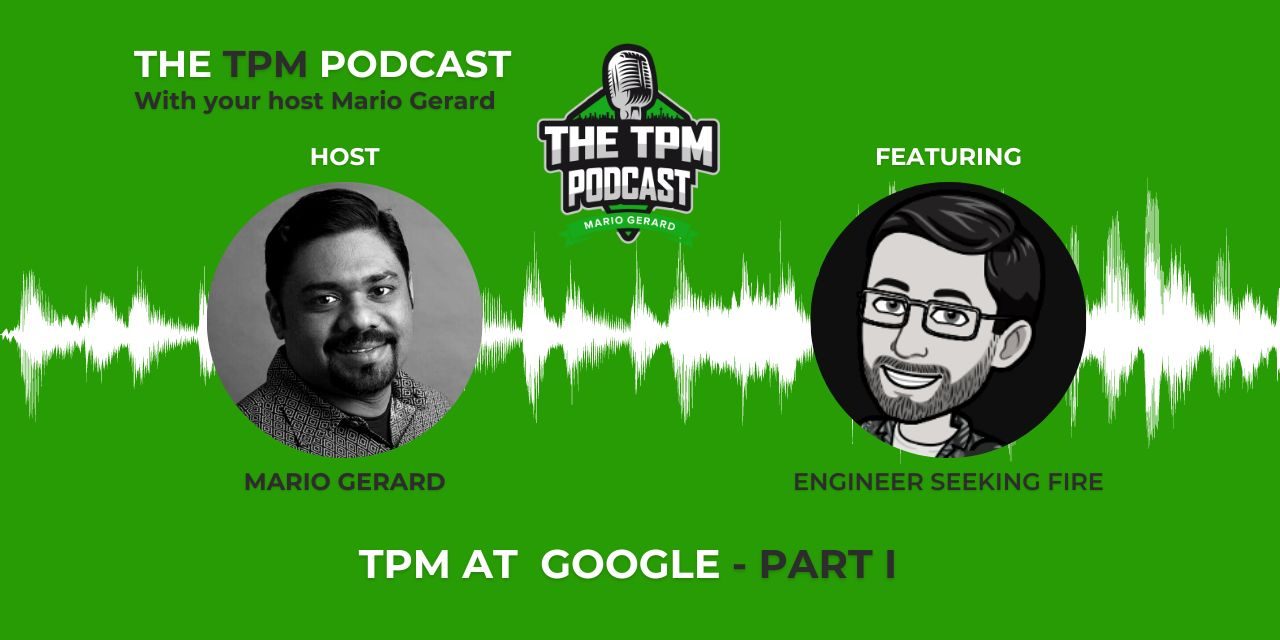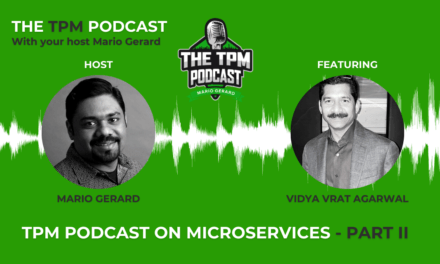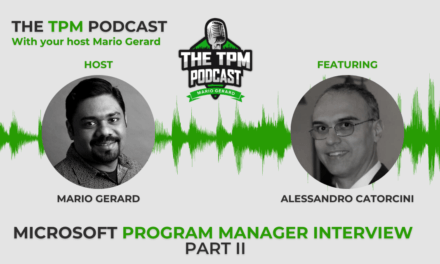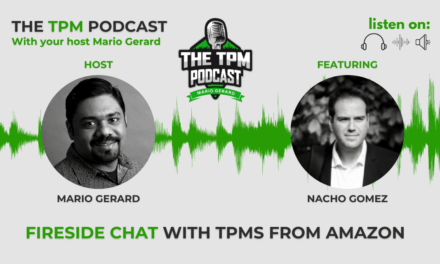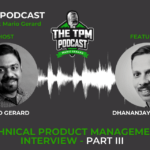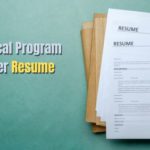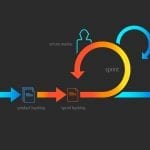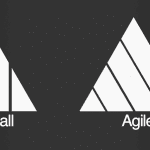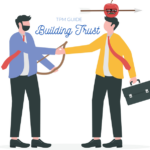Last updated on March 7th, 2023 at 01:26 pm
Podcast: Play in new window | Download | Embed
This is the Technical Program Management Podcast with the author of the popular blog Engineer Seeking FIRE. He has been a Technical Program Manager at Microsoft, Amazon, and is currently working as a TPM at Google. In this podcast, with Mr.ESF a TPM from Google we focus on the FIRE movement & the impact of COVID
Check out some of his best posts:-
In this podcast series, we talk about :-
- The speaker’s Blog and the FIRE Movement.
- The Impact of Covid on our current work environment
- The TPM role at Google
- How the TPM roles compare across – Amazon, Microsoft, Google
- Interview prep for TPMs ?
The podcast series is divided into three parts.
- TPM at Google: FIRE & COVID Part I
- TPM at Google: Comparing TPM Roles at Amazon, Microsoft & Google – Part II
- TPM at Google: Preparing for TPM Interviews at Amazon, Microsoft & Google – Part III
This is Part -I of the series, and we discuss the speaker’s blog, how it all started, we talk about FIRE, and the importance of financial planning and close this episode with the impacts of covid on our work as TPMs.
Thank you,
Podcast Transcript
Mario Gerard: Hello and welcome to the TPM podcast with your host Mario Gerard. Today we have a very interesting guest with us. He is the author of the popular blog engineers seeking fire. He has over 15 years of experience working in various tech organizations in a variety of roles from being a software engineer, a program manager, a product manager and a TPM.
He has been a TPM at Microsoft, at Amazon. And now he’s a TPM at Google. In this podcast, we will cover the essence, the core essence of the blog, which is “Engineer Seeking FIRE” and what FIRE means and why the author started the blog. We’ll maybe go into a little bit of impact we’ve had of COVID. And then we’ll dive really deep into the TPM role at Google, and how the author of the blog compares the TPM role at Amazon versus Microsoft versus Google. And maybe we’ll go a little bit into some discussion about how to prep for interviews at these various organizations.
Journey of the Engineering Seeking Fire blog
So one thing to note here is the author of the blog, engineer seeking fire is anonymous. I’m not going to name who he is, throughout this podcast, I might refer to him as Mr. ESF engineer seeking fire. So why don’t you tell us how this whole journey began, how you started this blog, and what your blog is all about?
Mr. ESF: Hey Mario. So first of all, thank you so much for inviting me to your podcast, I’ve been listening to it for quite some time now. I’ve learned a lot. So I’m really happy for your content, I’m really happy that you’re doing this. So thank you so much for organizing the podcast and for inviting me. A few things about my story. So I love the tech space. So I studied computer engineering and I have been always passionate about software engineering and writing codes. And after graduation, I got a great job, at a lot high tech company I was very proud, accomplished, you know, I lost my job as a software engineer. At the same time, though, as I was going through my finances, it felt as if I was getting by paycheck by paycheck.
So you know, having a great salary doesn’t mean that you’re living a very fancy life, especially as a new grad. So it felt like one paycheck was paying for my rent, the other biweekly paycheck was paying for my expenses and then that’s it. And then at some point, I was thinking about it, somebody pointed me to the book, Rich Dad Poor Dad, I’m sure you’ve read it probably or learned about it. And that changed my mindset, I thought that I learned that, you know, having a great income is not the solution for everything. What I understood is that my goal should be to become financially independent. So it must finding ways for my money to work for me.
So you know, I can spend X amount of hours every day working and make some money there. But I need to kind of multiply my efforts by having the money work for me. And the goal will be to have options. So it’s not that, okay, if I have much money, I’ll just retire and go to Hawaii and just spend all my time in the beach, it’s just to have options, you know, I might want to start my own thing. Or I might want to, you know, work in different roles, you know, the goal for being financial dependencies is to have many options. So the book focused specifically on getting a passive income through real estate investing. And it said that you can become financially independent when your expenses are less or equal to your passive income.
So the idea is that if you have passive income from real estate investing, and that’s more than your expenses then you don’t need to work, that’s the general idea. And However, even though the idea was great, it turned out that I was not into real estate investing, I didn’t want to buy properties and sell properties. So I started looking at other ways about how I could increase my money. So I looked at the stock market investing, I took classes, I read about this quite a bit.
But then the problem was that every time I bought a stock, it felt as if the stock fell, so I would buy, say Microsoft one day, and then Microsoft just fall a few days or if I buy Google or any other company, and then they just fall. So it felt like that, obviously 2008 hit at some point. So maybe that was part of it. But it was not you know, stock market investing just like that, it felt as if it didn’t have a strategy there. So I thought okay, you know, I need to get some more holistic understanding about finances, so I got an MBA, I’d say that now I’ll just leave tech, go get an MBA, learn more about how to think in the financial, how to get the financial education.
So I learned a lot of theoretical stuff, like the efficient market hypothesis, more than portfolio theory, all sorts of stuff. And the problem there is, again, you learn all the theory, but you don’t know what to do in your day to day life. So how do you transfer all this knowledge into something more actionable. So after the MBA, I started reading blogs, articles, I was diving deeper into financial articles, at the same time was also switching companies. So I went from Microsoft, I went to Amazon, I went to Google. And every company has lots of internal resources for financial stuff.
So they have lots of, some companies have FAQ’s, there might be internal websites and mailing list, lots of people who know how to maximize their money pretty much, how to optimize their investments. So I learned a lot from all these people. And they also learned how to maximize the benefits for each company. So every company has different benefits.
Mario Gerard: That’s really cool. Yeah, that you have different companies have different types of benefits, right. And understanding that is, that’s pretty important, too. That’s an interesting point.
Mr. ESF: And that helped a lot as I was going forwards. And then one day I learned about the 4% rule. And this 4% rule pretty much says that, when your annual expenses are 4% of your liquid net worth, then you are financially independent. So just to clarify what this means. So let’s say I have a portfolio for stocks and cars and bonds, which is $1 million. If my expenses of what percent of that, let’s say annual expenses are 4%. So if there are $40,000 or less, then I don’t need to work anymore.
With math’s, that’s the whole idea. And I can withdraw 4% every year, it’s inflation adjusted. So the first time it will be 40,000, then the next year, it will be 40,000 Plus, let’s say 3%, which is inflation. So there is almost 100% chance that I will not run out of money for 30 years, and in most cases, I will multiply my portfolio. So if I follow that, then after 30 years, I might have $2 million, or $3 million or end up with multiple of my initial portfolio. So that is what pretty much changed me. So now I knew my target, I knew that okay, I have expenses of X amount of dollars, I need to have 25x.
Now I have a target I can I know how much money I need to gain. I know how to, I had learned a lot about index funds, about investing. So I had everything else. And that is what made it click. So that’s how I started looking more into the fire movement. And that pretty much was the changing moments. And at that point, when I had the holistic picture, I was also saying that whenever I speak with friends about finances, they might not know some things that I took for granted. For example, one of the things that always shocked me is some simple things, for example, the 401k, right?
I would ask people, what is the maximum amount that you contributed for your 401k? And the usual answer that I get is always Okay, I maximize my 401k. And then my follow up question is always, what does maximizing your 401k mean? And then some people say, okay, you know, let’s say my company would say, if I put 6% of my income into the 401k, my company gives you another 3%. So I put that, and I will say no, that’s not maximizing your 401k. And then some others might say, Oh, you know, my 401k, the IRS says $19,5000, that’s the maximum I can put in my 401k. So I do that. And I will say no, that’s only for pretax 401k. So that’s not it. So I can put $59,000. And so some of it is pretax, some of it is post tax.
So every year I can put $59,000. And then you might be surprised, I’m not sure if you know, but Mario, but you might be surprised that that’s actually not the maximum that you can put in your 401k, you can put even more than that. So, even, and people don’t know, I did not know it until I switched some companies. So pretty much what the IRS says in this case is that you can put $59,000 per employer. So if you switch employers, let’s say you go from Microsoft to Amazon, you switch employers then you can put another $59,000 per year, so there are two limits, one is $19,500 in pretax 401k. And then that’s per individual, so per person, but then there is a $59,000 per employer.
So if you change you can put $116,000 in your 401K. Stuff like that. So I was learning these things and then because I started the blog in order to share this knowledge and help others in technology as well.
Mario Gerard: Interesting how you combined, I see a lot of your posts which are very financial centric. And then you have another set of posts which are like you bring the engineer, your technology background how that kind of combines with this. You know, so that’s very interesting your blog how you combine both the fire movement and the fact that you’re an engineer and how you bring both of that out.
Mr. ESF: And the way that they see it is that my ultimate goal is to help people become financial independence. And then there are two ways, there are multiple things that you need to do in order to do that. One is to increase your income. So increasing your income might mean I want to get to the next best job. I want to maximize my salary. So that’s one way to maximize your income. So that’s why all the career advice goes into the picture.
Should they be TPMS? PMS? How can they transition? What are the best paying companies. So that’s one area where I’m trying to help people. The other one is, again, in order to become financially independent, you need to reduce your expenses. So I have a lot of posts about how can we do that. You know, how other people are doing this. What are my expenses?
How am I minimizing my expenses? And then another area is again about investments. So how do you, if you save lots of money, how do you maximize the investment so that you can become financially independent earlier and how can you reach this 4% rule, as we said earlier, cluster.
Mario Gerard: And I think, you know, when I started getting interested in the fire movement, what my primary, what fascinated me was, the amount of time we spend working to earn money, versus the amount of time you’re spending to manage the money we have, right? I feel the amount of time generally how much time people spend managing money is so small, compared to the amount of time we put into earning that money. And if you spend more time managing money, generally, you’re going to get a much better outcome in all together, right?
Mr. ESF: That’s very true. Because let’s say somebody might be software engineer, so they might know lots of things about software engineering, they might be a great software engineer, might have a great salary. So they spend all this time at work, working on software engineering, maybe they learn, they like to spend their free time working on their own projects.
Or maybe they want to learn about, they want to learn from blogs, or read books, magazines, stuff like that. So they spent all this amount of time in software engineering, and in the Computer world, however, the money that they are making could multiply this if they spend a little bit more time in the investing side.
Mario Gerard: And not a lot of time. It’s not a lot of time they need. It is a fractionally larger amount of time than they are already spending. You don’t need to spend like 20 hours managing your money, trading stock, you just need to spend probably four or five hours a month, correct me if I’m wrong. Even that much if you can spend four to five hours a month in being more aware and managing your assets and bringing down your expenses, the rate of what you’re going to get in return is so many times more than actually putting those four hours into doing some work.
Mr. ESF: Correct. As soon as you have some investing strategy. So my investing strategy is about index funds and ETFs. So if you figured out that, okay, I want to invest say in a total stock market index fund, like BTSA X or in the S&P 500 index fund, you put all your money there, just let it increase. You don’t need to spend all this time investing stocks and looking at different trends and stuff like that. So just put all the money there just they need to set it up initially and spend some time to set it up, and then you’re good.
Mario Gerard: It’s surprising how my attitude towards finance was that Oh, it’s too complex, so complex that I do not want to spend my time understanding it. And the more I read it, the more I learned, I felt that, oh, it’s actually very simple. You just need to be disciplined about it. It’s not actually very complex. If you just use ETFs and index funds, there’s a likelihood that you will even beat the market, right? And you get a very reasonable predictable amount of return. Instead of doing something fancy.
So yeah, definitely folks who are listening do check out the blog, I’m going to put a link to the blog, the blogs URL is www.engineerseeking fire.com. And I’d definitely like you to go and visit that and spend some time because there’s a tremendous amount of valuable information on the blog.
So Let’s now move on to the second half of the podcast, where we’re going to talk about like more of the TPM world, but I definitely want to get the author’s perspective of what have you seen that are the impacts of COVID so far. So it’s been like March to March. So I think it’s like almost a year now, how have you seen like COVID change the work environment as a TPM?
Mr. ESF: So it changed quite a bit. And I see many differences between people and their performance if I compare the pre COVID versus post COVID. For example, one of the differences, people with young kids versus those who don’t have younger children, for example, if you don’t have young children, then maybe it’s better for you because you stay at home. So you don’t have to go to work, spend one hour, let’s say driving to work another one hour driving back from work.
So you save some time there, you’re also eating at home. So it’s much easier to not spend time to or money to just get outside, go to the cafeteria, come back. So you might gain more time, if you if you don’t have young children, then people can just work for many, many hours consecutively. And then Time flies you might not even sometimes I see people who are not even eating lunch, they just start at 9am, don’t eat lunch go to 9pm. And they’re super productive. And they love that. And you know, it’s a way for them to just produce an insane amount of work. And then at the same time, I see other people, especially with young children, where life is way more complicated now, because you might have children at home, you might, it might be way more difficult to arrange your time if you are parents, because now as a parent, let’s say people who have children who are going into elementary school, and now they’re being, they participate school from home, and they stay at home most of the day, you have to be with them, you have to spend more time with the children, it’s just not so easy to be as productive anymore.
Because your work and your time is split in half. You have during the work hours, sometimes you spend with your children, sometimes you have to be in meetings, and then you might be working late at night. And the schedule is all over the place. So it might be very different perspectives from a performance perspective from these types of two groups. So that’s one huge change that I see there. At least for me, another big difference is that pre COVID. I if I had the question, I would just walk to somebody’s desk, I would chat to get it out and then brainstorm. And then things would get solid way faster. Now it’s not so easy, because now I need to set up a meeting.
So even small things need meetings, and then the meeting might drag, and it might take a lot of time to get out the solution. So the chit chat and all the solutions that are being designed in whiteboards during, you know, in the corridor, you know, you just totally lose that. And then another thing is that, generally there is much less face to face time. So before it was much easier to build relationships, so you knew the team, you go to coffee shops, learn about them, and, you know, build relationships. Right now, it’s much more difficult to build, especially if you’re, let’s say changing teams. So if you’re joining a new company, it’s not so easy to do go on with a team. So these are three main areas where I see the difference.
Mario Gerard: That’s really important points. For me personally, I think the thing that affects me the most is the fact that if I count the number of new relationships that I’ve built over the last one year, it’s fairly less. And if you look the previous year, how many new relationships I had built, it was generally you know, at least like 10 to 15m 20 people, 30 people are very close, I take them out for coffee, we go for walks, all those things. I think all of those the number of new relationships if I count, which I built for the last one year has definitely gone down.
Like close relationships with people, right? That’s definitely taken a nosedive with not having to meet in person and doing everything over zoom. And when you do things over zoom, right? I feel that it’s generally more businesslike, having a very casual personal conversation does not generally happen on zoom. And that’s because it’s hard to switch on and off between meetings. It’s very, very if you’re a TPM, you’re on zoom probably like six hours a day. So it’s very hard to context switch, and switch your type, you know, your personality between zoom calls.
So yeah, that’s the hardest thing. How do you see the work environment changing, you know, like as we get our vaccines and as we maybe start going back to work, what do you think is going to happen?
Mr. ESF: So, I hope that it will get back to normal after we get the vaccine. However, I’m not sure about the timelines, I think there will be a transitional period. But even if we start getting vaccinated, people will just be afraid of going back to work, the people might not would like to get the vaccine, some people are suspicious about the vaccine. So I think that there will be a lot of transition period until we return back to let’s say normal life.
So I think in this transitional period, there are a few things that will be key as a TPM, for example. One is business communication. So if you don’t show up online, then people have no idea as a TPM what you’re doing, right? It’s pretty much, you need to show up, you need to show your work, you need to talk to people. And if you don’t, then people might even not even know that you’re there.
Mario Gerard: And you need to be available as well.
Mr. ESF: You need to be available. Yes. Correct.
Mario Gerard: Yeah, I think being available. So if you’re working in different time zones, or across time zones, then somehow you have to at least try to be available for the other party. You know, and with that, as you said, right, if you have kids, and you’re trying to split your day with your spouse, then it even becomes even more tricky. So yeah, that’s totally true.
Mr. ESF: Especially, and this is a double edged sword. So if you just want to coast by and other people, there are some people who will do that. So if you want to coast by then being invisible might help. But if you want to show you know, be productive, make an impact, then obviously, this doesn’t help. So you definitely want to be in touch with the developers and have much more communication. There are vims, we have meetings, you need to ask the TPM in this transitional period, you need to show that you’re there and you need to show a good value.
And then very late with this, you need to ask a TPM, you need to have personal, I think it’s very difficult to as we said before, to exceed, maintain personal contacts. But it’s very important to do. Until we get back to the office, it’s very important to remember that okay, in order to build a relationship with somebody, I need to ask him about personal things, I need to instead of just focusing on keeping all the meetings on the business level, ask how their life is doing.
Talk to, schedule one to one meetings with people, just chat, just to have a visual coffee chat a meeting, instead of you know, asking them all the time about the what’s the status? Or you know, are we on track, or any business related item. I did that with a few people, it’s always helpful to have a casual coffee chat, and just avoid all the data related from all the work topics there.
Mario Gerard: Try not to talk about work, but talk about anything but work.
Mr. ESF: Anything but work. Yes.
Mario Gerard: That’s the goal.
Connection and Participation
Mr. ESF: Another thing is pretty much as a TPM, you need to make sure that everybody is connected. So, you know, you hear all the time in meetings. But let’s say it’s a meeting with 10 people, there might be two or three people speaking and they just most of the time, if everybody was sitting around the table, it might be easier for people to speak up. Right now what they see is that, you know, in the larger meetings, especially there might be a few people who talk a lot, but then other people are hiding. So even though they might have something important to say so how do you help people be a little bit more proactive? How do you help them participate in the discussion? Can you just spot in a meeting who is struggling offer your help. Can you encourage people to participate more. So I think as a TPM this is really important stuff.
Mario Gerard: And I think what you’re saying is doing it virtually is little more trickier. Like we used to always used to do that, right? Always used to make people speak up, but I think doing it virtually, you got to be more aware of who’s speaking and who’s not speaking, who’s actually there. Like all of those things, do it virtually I think it’s a little more difficult.
Mr. ESF: It’s tricky if you have to amplify your status here and
Go to the next level in especially communication and then your emotional awareness and understanding about what’s happening within the team. So I think that it’ll take a long time until we go back into pre COVID situations where everybody’s sitting in the same room without masks and without, everybody’s going for coffee chats. So until that time happens then there is all these things that need to, as a TPM, you need to be aware of these things and amplify just gives it like that.
Working form home
Mario Gerard: Yeah. And I think what’s going to happen, like how I see the future is that once things settle down, and a good large percentage of people get vaccines, then what are you going to see in the workforce is you’re going to see most of the people come in to work like two, three days a week, or two days a week. And teams picking, or my team’s going to come in on Monday and Tuesday, most of my team is going to try to make it but we’re not going to come in every single day of the working week, I think it’s going to be a very blended work from home and coming to work kind of environment. Because a lot of people have also started enjoying working from home from some perspective, at least they don’t need a commute, and they are saving so much time, right?
And then, also, from a hiring perspective, if you look at a lot of companies now have started hiring all across the United States, right? Not just in Seattle, or not just in California, right, they’re open, they are completely open to a whole set of candidates, we’re not location specific anymore. So it’s getting kind of be interesting to see how the new work environment, even if that’s one or two years from now, how that looks, I think it’s going to be fairly different from what you and I are used to seeing in the last 5,10 years.
Mr. ESF: That’s a great point about remote hiring. That’s a great point. Because, again, at this point, the before, the team might be only one location, but right now, it’s very easy to hire somebody in a totally different location. And since everybody just videoconferencing, then it doesn’t matter if everybody’s in one place if everybody’s in different places. So at some point, who knows what will happen? Just give you the conferencing like that. That’s another interesting point.
Mario Gerard: Yeah, and the hiring at other locations also has been extremely cost effective for organizations, right? So we’ve now started hiring in, you know, in different cities across the United States where the salaries are not as high as California or Washington. So it’s a whole new, I don’t know how this is going to play out. So it’s getting kind of going to be interesting. Go ahead.
Mr. ESF: It’s not only from the perspective of employer who is not hiring in California, and somebody might want to work, let’s say for a high tech company, let’s say Facebook, Google, but they might not want to spend 10% of California tax and spend more money to have the same level of life by living in California, but they might be able to live in, let’s say, somewhere with a lower cost of living and enjoy their life there while they’re still working for one of these companies. Many people who live from California had to go somewhere else.
Mario Gerard: Oh, absolutely. Yeah. And I think yeah, if you especially if you have family, right, and you can’t leave a city, it makes a lot of sense, to, you know, to work out of another city other than California or Washington State. Cool.
That’s the end of this episode, my friends. Stay tuned for the next episode, where we go into talking about how the TPM role varies between Google, Amazon, and Microsoft. It’s a really, really cool episode. And then also visit the website to get the link to the blog, the engineer seeking fire blog, and to go through the notes from the podcast and the podcast transcript. See on the other side, thank you.

